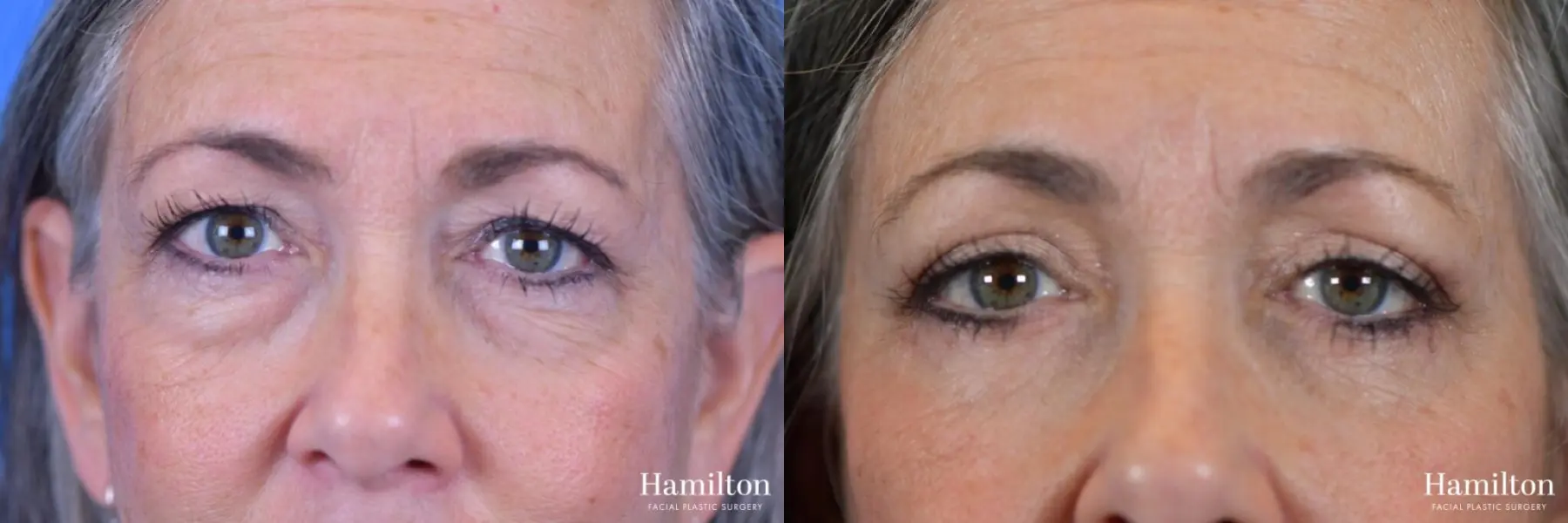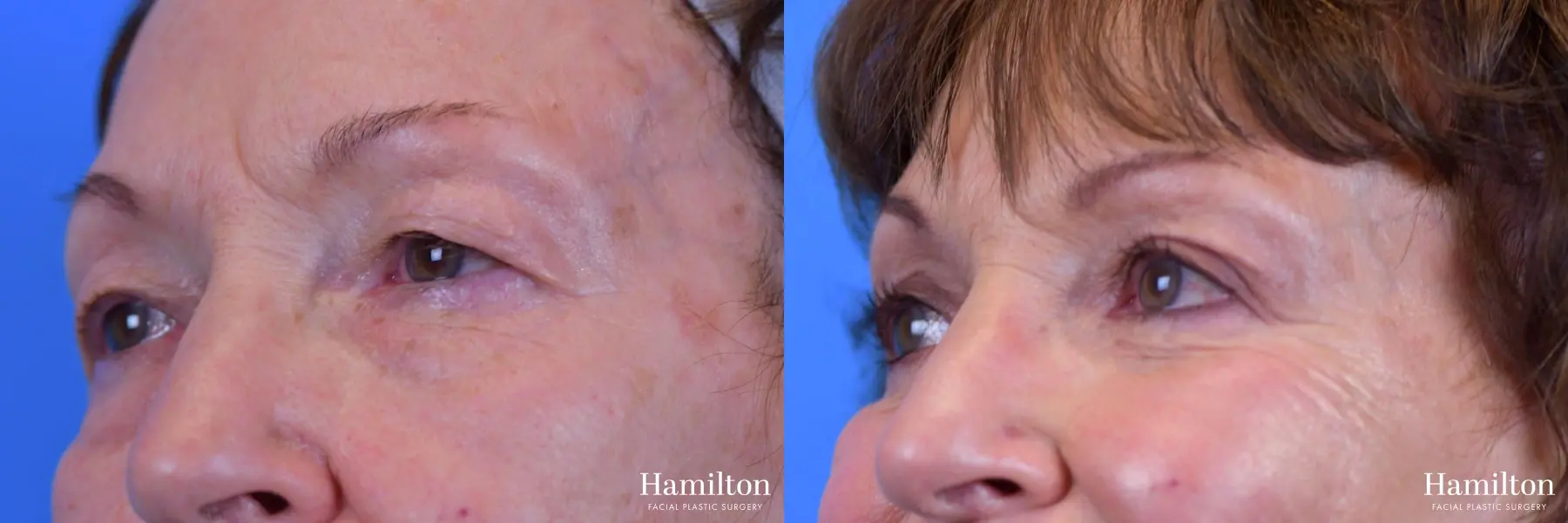Blepharoplasty (Eyelid Surgery) in Indianapolis, Indiana
Located in Carmel and Greenwood, Hamilton Facial Plastic Surgery, led by double board-certified facial plastic surgeon Mark M. Hamilton, M.D., F.A.C.S., offers blepharoplasty for men and women who live in and around Indianapolis, Indiana. Blepharoplasty, or eyelid surgery as it is more commonly known, is a plastic surgery procedure designed to restore a more youthful and refreshed appearance to the eye area. It is one of the most popular cosmetic surgery procedures performed today. During the surgery, excess fat, skin and muscle are removed from the upper and/or lower eyelids. This helps to improve drooping upper eyelids and puffy under eye bags. Eyelid surgery may also improve vision if excess upper eyelid skin is interfering with sight.

What is Blepharoplasty?
This form of facial plastic surgery is used to create more youthful-looking eyes. Also known as eyelid surgery, blepharoplasty is one of our most popular cosmetic surgery procedures.
How Much Does Blepharoplasty Cost in Indianapolis, Indiana?
Hamilton Facial Plastic Surgery seeks to make facial surgery procedures available and affordable for everyone. To accomplish this, we accept cash, major credit cards and personal checks for blepharoplasty.
Am I A Good Candidate For Blepharoplasty?
Just like with any other cosmetic procedure, you’ll need to be in good health and have realistic expectations of your procedure’s outcome. If you have a circulatory or ophthalmologic condition, you may not be a good candidate for this procedure.
How is Blepharoplasty Performed?
During the surgery, Dr. Hamilton will remove excess skin, fat and muscle from the upper and/or lower eyelids. Dr. Hamilton generally makes an incision in the crease of your upper eyelid and below the lower eyelashes. Excess skin will be removed by working through the incisions. Sagging skin and muscle will be trimmed and then the incision will be closed.
Eyelid surgery doesn’t just eliminate puffy eyelids and under eye bags, it can also improve vision when in cases where the upper eyelid is interfering with a patient’s eyesight.
How Long Does Blepharoplasty Take?
Eyelid surgery, or blepharoplasty, takes between one and three hours to complete. You will be given local anesthesia and sedation or general anesthesia depending on your case.
Before and After Pictures
What If I Don’t Have Excess Skin?
If you just have a pocket of fat beneath your lower eyelids, transconjunctival blepharoplasty may be performed. An incision will be made inside your lower eyelids to eliminate the excess fat.
Blepharoplasty Recovery
After eyelid surgery, a bandage may be temporarily applied to the eyelids. Patients can expect some bruising and swelling, with most of the bruising fading within two to four weeks. Discomfort can also occur, in particular, a tight or sore sensation in the eyelids. Pain medication can be prescribed to help relieve these symptoms. Other side effects that may occur during the first week after surgery can include dry, itchy or burning sensations of the eyes, tearing, sensitivity to light and blurred or double vision. Stitches are generally removed on day seven. It will take about seven to 10 days before work, and other normal activities can be resumed and about three weeks before resuming more strenuous activities.
When Will My Stitches Be Removed?
Stitches are normally removed on day seven after the surgery.
When Can I Return to Work?
Seven to 10 days after your surgery you can return to work. It will take about three weeks to resume more strenuous activities.
Considering Blepharoplasty?
If you are considering eyelid surgery, it’s important that you be in good physical health and that you have realistic expectations for your surgery’s outcome. Surgery may not be indicated for patients with certain circulatory or ophthalmologic conditions.
The surgical time for blepharoplasty typically lasts between one and three hours, with either local anesthesia and sedation or general anesthesia being used. Incisions are usually located in the crease of the upper eyelids and just below the lashes of the lower eyelids. Working through the incisions, excess fat is removed, sagging skin and muscle are trimmed and the incisions are then closed. A procedure known as transconjunctival blepharoplasty may be performed on patients without excess skin and just a pocket of fat beneath the lower eyelids. For this procedure, incisions are made on the inside of the lower eyelids.
How Do I Get Started With Blepharoplasty?
You’ll need to schedule an initial consultation with Dr. Hamilton. Be sure to prepare a list of any questions or concerns you may have. At your initial consultation, you’ll have time to ask questions and learn more about the cost of facial plastic surgery. Remember, it’s important to maintain realistic expectations. There are many factors you need to consider such as your medical history and pain tolerance. Your results will not be noticeable immediately. You’ll have to wait for the swelling and bruising to subside and, in some cases, this can take months.
Will My Blepharoplasty Be Covered By Insurance?
Eyelid surgery, if performed specifically for aesthetic reasons, is not generally covered by insurance. However, if it is being performed for medical reasons insurance may cover all or some of the costs. Patients should be sure to check with their insurance carrier.
Post Operative Blepharoplasty Instructions
Introduction
The following is a list of general instructions for your care following your surgery. Please read them carefully several times as most of your questions should be answered here. Instructions for your care will also be reviewed the morning after surgery. Carefully following these instructions should help you get the best results from your surgery.
After Surgery
It is important to keep cold compresses on the eyes the first 48 hours after surgery. This can be done with cold wash clothes from a basin of ice water or with Swiss Therapy Mask. Do not use an ice bag. Wash clothes should be changed every 20 to 30 minutes through the first night to keep them cool. You should plan on remaining within thirty miles from the location of your surgery for this first night. It is also important for you to keep your head elevated the evening after surgery as well as for the first two weeks following surgery. This can be done by either sleeping in a recliner tilted at 45 degrees or sleeping with two pillows underneath the head. Avoid rolling onto your face. Sleeping on your back for the first two weeks after surgery helps to ensure this.
Daily Care
This care will be reviewed the morning following your surgery:
- Apply two to three drops of the Bion tears drops in each eye three times a day (Do this prior to cleaning the suture line).
- Go over suture lines three times daily with hydrogen peroxide on a Q-tip. After this again with a Q-tip apply a liberal amount of the antibiotic ointment (Bacitracin ophthalmic or Maxitrol ointment).
- At night, put a small amount of either lubricating ointment or if not available antibiotic ointment in the eye to keep them moist.
- You may shower the second day following surgery and should shower everyday following this. Be sure to use a gentle shampoo such as Johnson’s Baby Shampoo.
- Be sure to report immediately any signs of bleeding that persist after ten minutes of direct pressure, infection, redness, fever, unusual drainage, or pain.
- Stitches will be removed at the one-week point.
Restrictions
- No strenuous exercise for at least two weeks.
- No heavy lifting for three weeks.
- Wait ten days to two weeks prior to putting your contacts in. You may begin wearing your glasses the day following surgery.
- No tweezing of the eyebrow for two weeks.
- Hair coloring should be delayed for four weeks after surgery.
- No driving for one, preferably two weeks after surgery.
- Eye shadow and false eyelashes should not be applied for two weeks after surgery.
- Make up should not be applied for two weeks after surgery.
Finally
The healing time for blepharoplasty surgery is often less than expected and the results are worth the wait. While swelling should be completely gone after four to six weeks, your healing will continue for the entire first year. I will follow you through this entire process, but be patient.
Please do not hesitate to ever contact our office.
Mark M. Hamilton, M.D., F.A.C.S., is recognized as one of the “top physicians” in America for facial plastic and reconstructive surgery. As a double board-certified plastic surgeon, specializing solely in cosmetic facial procedures, Dr. Hamilton provides his Indianapolis patients with exceptional skills and results that last. For more information on blepharoplasty or to schedule a private consultation at Dr. Hamilton’s Carmel or Greenwood office, please contact us.










